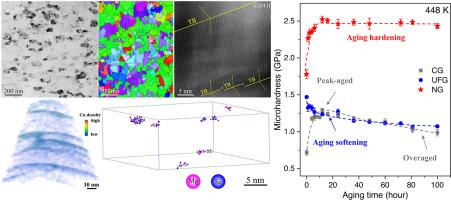Unlocking ultrahigh strength in dilute Al alloys: The synergy of stable grain boundary networks and solute clusters
IF 8.3
1区 材料科学
Q1 MATERIALS SCIENCE, MULTIDISCIPLINARY
引用次数: 0
Abstract
The strength of Al alloys can be significantly enhanced through grain refinement and aging hardening. However, improving strength through aging hardening in nanograins is challenging due to the poor structural stability, which leads to grain growth and precipitation coarsening. Herein, a nanostructured AA6061 alloy with grain size of 26 nm and a high proportion of relaxed grain boundaries (GB) was fabricated using cryogenic high-pressure torsion (HPT). During aging treatment, Mg-Si-Cu co-segregated at GBs and high density of Mg-Si solute clusters (approximately 5.6 × 1023 m-3) rather than intermetallic precipitates formed within the nanograins, resulting in a record strength as high as 805 MPa. The solute clusters exhibited an excellent thermal stability against prolonged aging at higher temperatures, which can be attributed to the stable GB networks. This work presents a promising prototype for designing high strength and thermally stable nanocrystalline Al alloys through the synergy of stable GB networks and solute clusters.


解锁稀铝合金超高强度:稳定晶界网络和溶质团簇的协同作用
通过晶粒细化和时效硬化可以显著提高铝合金的强度。然而,由于纳米晶粒的结构稳定性差,导致晶粒长大和析出粗化,因此通过时效硬化来提高强度是具有挑战性的。采用低温高压扭转(HPT)法制备了晶粒尺寸为26 nm、晶界松弛率高的AA6061纳米合金。时效处理过程中,Mg-Si- cu在gb处共析出,形成高密度的Mg-Si溶质团簇(约5.6 × 1023 m-3),而不是在纳米颗粒内形成金属间析出物,强度高达805 MPa。溶质团簇在高温下表现出优异的热稳定性,这可归因于稳定的GB网络。这项工作为通过稳定的GB网络和溶质团簇的协同作用设计高强度和热稳定的纳米晶铝合金提供了一个有希望的原型。
本文章由计算机程序翻译,如有差异,请以英文原文为准。
求助全文
约1分钟内获得全文
求助全文
来源期刊

Acta Materialia
工程技术-材料科学:综合
CiteScore
16.10
自引率
8.50%
发文量
801
审稿时长
53 days
期刊介绍:
Acta Materialia serves as a platform for publishing full-length, original papers and commissioned overviews that contribute to a profound understanding of the correlation between the processing, structure, and properties of inorganic materials. The journal seeks papers with high impact potential or those that significantly propel the field forward. The scope includes the atomic and molecular arrangements, chemical and electronic structures, and microstructure of materials, focusing on their mechanical or functional behavior across all length scales, including nanostructures.
 求助内容:
求助内容: 应助结果提醒方式:
应助结果提醒方式:


